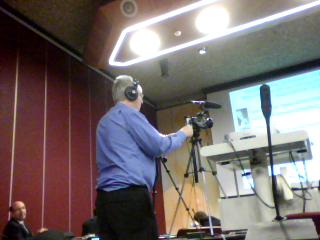Day 2 of the OFE Conference
Tuesday started bright and early for me, I was in the CICG just after 7am, setting up the ODF showcase. The showcase consisted of an assorted bunch of laptops set out on a table running an assortment of ODF compatible software.
There were a number of good sessions during the day, I only attended a few because I was answering questions at the showcase and perfecting my demo for the Wednesday.
 The conference keynote session was held in the evening, interesting fact for Groklaw readers, the keynote was recorded by Sean Daly and will be published soon.
The conference keynote session was held in the evening, interesting fact for Groklaw readers, the keynote was recorded by Sean Daly and will be published soon.
Bob Sutor, HÃ¥kon Wium Lie, Andy Updegrove and
Vint Cerf
Interestingly both Andy and Vint declined to use the projector and just spoke from their notes.Vint uses a Mac.
I won’t attempt to summarise their speeches as the whole event was recorded by Sean Daily, Groklaw’s roving reporter. There should be a webcast available in a few days.
The Q&A session after the speeches was most entertaining. I asked a question about whether the panel could think of a situation in any field where duplicate competing standards benefited the consumer. This led on to a question from Graham Taylor, the moderator, who asked directly whether the panel thought there should be both ODF and OOXML.
I had been attempting to discover how long the human body can survive on a diet of canapés and petit fours but I was quite happy to curtail my experiment and go out for a fondue with a bunch of the organisers and attendees.



So what was the answer to your question?
basically no, duplicate standards don’t benefit the consumer. Things like imperfect GSM standards lead to quad band phones, i.e. the phone deals with 4 times the number of bands it needs to do. Bluetooth vs WiFi was an interesting example where at the beginning it was not well understood that the different roles of the two wireless technologies were quite different and not overlapping much. Turns out both standards are useful.
Nobody thinks OOXML should be an international standard, but this answer was somewhat of a foregone conclusion. Andy Updegrove thought that OOXML was possibly a bit different to ODF in it’s aims, I didn’t quite follow all of his logic on this, but it will be in the video and transcript next week sometime. OOXML is different in it’s aims. It is aim is to represent and preserve the idiosyncrasies of Microsoft’s legacy formats, Microsoft wants it to be an international standard so that Microsoft gets to bid for government contracts and persuade governments to mandate that their citizens send and receive documents in Microsoft formats using Microsoft software.